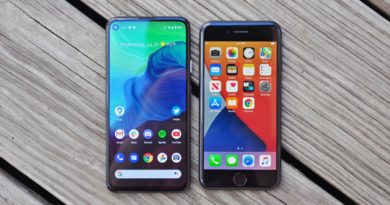Most anticipated phones of 2020
![]()
From the futuristic-yet-flawed Motorola Razr to the Samsung Galaxy S20 range, we’ve already seen several smartphone launches so far in 2020 that have pushed boundaries in terms of design and performance. And we’re just getting started.
There’s the Pixel 4a — Google’s follow up to the surprise success of the Pixel 3a last year that led Mountain View to sell more handsets than ever before in 2019. Samsung will follow up its latest batch of flagships with the Galaxy Note 20, likely in the summer, which has been tipped to offer a new fast-refresh-rate display optimized for reduced power consumption, as well as speedy eUFS 3.1 storage.
And that’s to say nothing of Apple, whose iPhone 12 could very well be the company’s first with 5G onboard. A new, more budget-minded iPhone SE successor, rumored to be called the iPhone 9, could drop before then — though reports indicate that launch has been pushed back as yet another consequence of the global health crisis.
Here’s a peek at new phones in store for 2020.
Google Pixel 4a (Summer 2020)
The Pixel 3a was a massive success for Google’s mobile division, doubling the number of smartphones the company shipped last year (even though it only spent half of 2019 on the market). Therefore, it should come as little surprise that Mountain View is reportedly planning a successor, unsurprisingly named the Pixel 4a.
Rather, the bigger surprise is the way the Pixel 4a might look. The render you see above, provided by 91Mobiles and based on information attained by Steve Hemmerstoffer (better known as @OnLeaks) paints a Pixel 4a with a decidedly more cutting-edge look than Google’s current flagships. There’s a consistently slim bezel encircling the display, as well as a Samsung-esque hole-punch cutout for the front-facing lens. More recent leaks have indicated that this aesthetic will likely hold true for the final release.
Wired headphone stalwarts will be pleased to find a 3.5-millimeter headphone jack in this mockup, and eagle-eyed readers will note the capacative, rear-facing Pixel Imprint sensor around back. (The Pixel 4a assuredly won’t be capable of sophisticated — and expensive — facial identification.) Interestingly, the Pixel 4a’s rear camera stack has retained its square housing from the Pixel 4 line, even though it carries only one lens.
iPhone 9 (Mid 2020)
Rumors about the iPhone 9, or iPhone SE 2, are beginning to pick up again, as people pine for a successor to Apple’s compact, inexpensive iPhone.
Reports have overwhelmingly suggested the new entry-level iPhone won’t be as small as its predecessor, with a 4.7-inch screen that’s reminiscent of the iPhone 8. But the new handset would still be plenty powerful, reportedly running on the same A13 Bionic chip found inside the iPhone 11 family.
The big question surrounding the iPhone 9 at this time, however, is launch. Originally, the device was on track to ship within the first three months of 2020, according to analyst Ming-Chi Kuo. However, some sources are now claiming that the iPhone 9 launch is off for now because of the coronavirus outbreak, even as others say that it has already entered mass production. We likely won’t have more clarity on the situation for a few weeks more, but we’re curious to see how Apple reacts.
iPhone 12 (Fall 2020)
With the iPhone 12 range roughly half a year out at this point, the rumor mill is starting to churn in full force. This year we’re expecting new flagship iPhones in four sizes, stretching all the way from 5.4 to 6.7 inches. Some will feature 5G connectivity and groundbreaking new cameras with sophisticated, “world-sensing” 3D cameras, while others will forgo those luxuries to achieve a more reasonable price. And this time around, every new iPhone could benefit from an OLED display with an increased refresh rate of 120Hz, doubling the smoothness of conventional displays.
Regardless which of those particular features come to pass, however, we’re expecting a sizable boost in performance from the forthcoming models. In fact, leaked benchmarks have already indicated that the iPhone 12 will blow away the Galaxy S20 and other Snapdragon 865-powered Android flagships, thanks to Apple’s next-generation A14 Bionic chipset. Of course, we will only know more as we draw closer to the reveal, though we’re finally starting to gain a comprehensive picture of Apple’s plans.
Samsung Galaxy Note 20 (Summer 2020)
Rumors are still fresh on the Samsung Galaxy Note 20, reportedly nicknamed “Canvas.” As the Note series typically picks up where Samsung’s Galaxy S models leave off in terms of camera hardware, we wouldn’t be surprised to see the company’s net phablet lift the Galaxy S20 Ultra‘s remarkable (if a little unpolished) 108-megapixel main shooter, or perhaps its periscope lens, capable of 4x optical zoom.
That said, we have heard some tidbits about aspects of the Note 20’s hardware. Namely, that it could feature really, really fast storage that eclipses even the UFS 3.0 flash memory implemented in the S20 range; and that Samsung is working on a more “finely-tuned” 120Hz screen, according to well-known leakster Ice Universe. The global pandemic could force Samsung to dodge its timetable of course, though we still expect to hear more on the Note front as the year progresses.
Microsoft Surface Duo (Holiday 2020)
No, you didn’t fall haplessly into a time machine that’s sent you five years into the past — Microsoft is actually making a Surface phone. And not just any phone; one that has two screens and runs Android. The Surface Duo, revealed a year before its tentative holiday 2020 launch, features a pair of Gorilla Glass-covered 5.6-inch displays joined by a hinge down the middle. It’s not truly a foldable, in that the screens themselves don’t bend. Rather, they can rotate 360 degrees, so you can use the device in several different orientations.
Like other Android flagships, the Surface Duo is powered by Qualcomm’s Snapdragon 855 processor, according to Wired — though Microsoft was quick to point out that it doesn’t see the device strictly as a phone. Still, the 855 will be outdated by the time the device eventually launches, which also raises the question of whether or not the Surface Duo will support 5G. Microsoft made no mention of it during the unveiling, but if other late 2020 flagships support next-gen networks, the company’s first phone in years will look mighty outdated if it doesn’t as well. (And that’s to say nothing of the phone’s ginormous bezels.)
Still, there’s lots of time for Microsoft to refine and improve the Surface Duo’s design before it hits the market alongside the larger Surface Neo tablet. What we’re seeing now is clearly an early look — though it’s still certainly piqued our interest.


